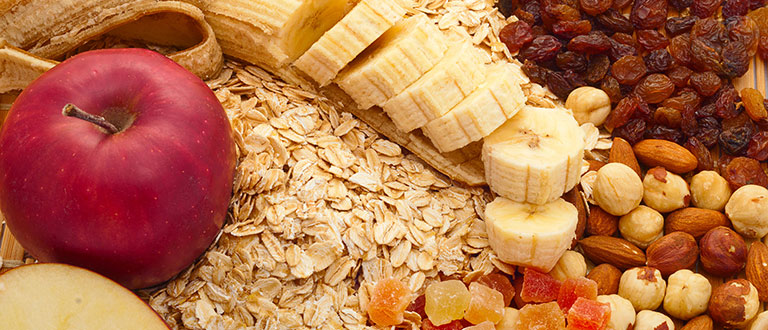What Does Dietary Fiber Do? The Physiological Effects of Fiber

The American Association of Cereal Chemistssays “Dietary fiber is the edible parts of plants or analogous carbohydrates that are resistant to digestion and absorption in the human small intestine with complete or partial fermentation in the large intestine. Dietary fiber includes polysaccharides, oligosaccharides, lignin, and associated plant substances."1
That's what it is; but what does dietary fiber do? Put simply, dietary fiber plays an essential role in human health—specifically colonic health—but its influence also extends to many other functions of the body. Increasing dietary fiber in an individual’s diet is associated with a significant number of health benefits, including reduced risk of constipation, diverticular disease, hemorrhoids, diabetes, obesity, and coronary heart disease.
Increased consumption of dietary fiber is also believed to reduce the risk of cancer of the large bowel, but the evidence to date is equivocal. The scientific body of evidence is deemed sufficient to include blood cholesterol attenuation, blood glucose attenuation, and improved laxation as benefits listed in the definition, so we're exploring those three areas further so you know how your product ultimately impacts your consumer.
Our lab services include comprehensive fiber tests. Learn more
What Are The 3 Physiological Effects of Dietary Fiber?
Reduced Cholesterol
Reducing the risk of developing coronary heart disease (CHD) by increasing the consumption of dietary fiber was amongst the earliest observations of workers in dietary fiber research. CHD is a long-term onset disease, so correlations between dietary fiber intake and the disease rely primarily upon epidemiological studies.
Total (TC) and low-density lipoprotein (LDL) associated plasma cholesterol are accepted as biomarkers, i.e. reductions of elevated TC and LDL levels are considered acceptable measures of risk reduction. A meta-analysis of 67 studies (oat products-25, psyllium-17, pectin-7, guar gum-18) of soluble dietary fibers showed a significant reduction in TC and LDL with increased dietary fiber intake.
The 1993 regulations of the Nutrition Labeling and Education Act allowed a CHD claim for high fiber foods—i.e., whole grains, fruits, and vegetables—which means they may be effective in reducing CHD risk. Specific claims for products that include oat/oat bran and psyllium are also allowed, based on extensive research data accumulated in recent decades.
Reduced Blood Glucose Levels
Diabetes has been a concern of the human population since the inception of recorded medical research. Diabetes extracts a tremendous toll in money and human misery with an estimated 422 million cases worldwide in 2014, equating to 8.5% of the global population, according to the World Health Organization. Increased dietary fiber consumption has shown beneficial effects for Types 1 and 2 diabetics, improving glucose tolerance, reducing insulin requirements, increasing peripheral tissue insulin sensitivity, decreasing serum cholesterol and triglycerides, and obtaining better weight control.
Soluble dietary fibers exhibit the greatest therapeutic effect. An immediate physiological effect can be measured on the blood glucose levels for several hours after ingestion of a food versus glucose. Glucose causes a rapid rise (30-60 minutes) then a fairly rapid decline (30-90 minutes) in serum glucose as insulin secretion increases. Rapidly digested foods closely follow the pattern of glucose but for high-fiber foods, the increases and decreases in serum glucose are much slower and do not reach as high a maximum level.
Improved Laxation
Improved laxation is a very important physiological effect of dietary fiber and one that provides significant comfort to consumers. It's a benefit that's almost taken for granted—the discomfort of constipation and the increased risk of other diseases resulting from constipation such as diverticular disease and hemorrhoids should not be understated.
Dietary fiber results in increased fecal bulk, frequency and regularity of defecation, reduction of transit time of fecal material through the large intestine, and reduced stool hardness. Softer stool results in less discomfort to the colon and anus and less strain on the muscles involved in defecation.
In 1999, U.S. consumers spent $870 million on over-the-counter laxatives—a number that has steadily increased each year and reached $1.3 billion in 2016. Increasing dietary fiber intake also typically lowers the pH of the colon with an accompanying increase in total intestinal microflora mass and a shift in intestinal microflora species distributions—all of which are considered beneficial effects.
What Consumers Need to Know?
We know whole grains, fruits, and vegetables are naturally high in dietary fiber. Many dietary recommendations focus on consuming these foods because nutrition experts believe other components of the high-fiber food may be contributing to additional health benefits. But which high-fiber foods benefit consumers most?
Since humans are unable to synthesize dietary fiber and must depend on their food for adequate supplies, this chart of common ingredients can help inform decisions manufacturers make about ingredient usage and impact what consumers eat.
| Dietary Fiber Content of Common Foods | |||
Food | grams of fiber/100g | Food | grams of fiber/100g |
Almond | 10-11 | Oat bran | 16.5-17.5 |
Apple (peeled) | 1.5-2 | Oatmeal | 1.5-2.5 |
Apple (skin on) | 2-3 | Orange | 1.5-2.5 |
Asparagus | 1.5-2 | Peanuts | 1-2 |
Banana | 1.5-2.5 | Potato | 1.5-2.5 |
Broccoli | 3-3.5 | Spinach | 2.0-2.6 |
Cabbage | 1-2.5 | Strawberry | 1.8-2.3 |
Cashew | 3-4 | Tangerine | 1.8 |
Melon (cantaloupe) | 0.5-1 | Walnuts | 10-11 |
Sometimes it's difficult for food scientists to remember how much they're impacting consumers—helping manufacturers make decisions about ingredient usage and informing dietary recommendations are just two of the myriad ways. For more on this topic, check out our recent blog post, "How Food Labs Contribute to Consumer Health."
Let's Get to Work!
Submit your order online and ship your samples today. If you have questions, we are always here to help.
Medallion Labs+
A food testing program designed with mid-market and enterprise food and ingredient manufacturers in mind.
- The Definition of Dietary Fiber. Report of the Dietary Fiber Definition Committee, CFW, March 2001.